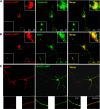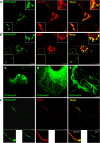Increased expression of reticulon 3 in neurons leads to reduced axonal transport of β site amyloid precursor protein-cleaving enzyme 1
- PMID: 24005676
- PMCID: PMC3798490
- DOI: 10.1074/jbc.M113.480079
Increased expression of reticulon 3 in neurons leads to reduced axonal transport of β site amyloid precursor protein-cleaving enzyme 1
Abstract
BACE1 is the sole enzyme responsible for cleaving amyloid precursor protein at the β-secretase site, and this cleavage initiates the generation of β-amyloid peptide (Aβ). Because amyloid precursor protein is predominantly expressed by neurons and deposition of Aβ aggregates in the human brain is highly correlated with the Aβ released at axonal terminals, we focused our investigation of BACE1 localization on the neuritic region. We show that BACE1 was not only enriched in the late Golgi, trans-Golgi network, and early endosomes but also in both axons and dendrites. BACE1 was colocalized with the presynaptic vesicle marker synaptophysin, indicating the presence of BACE1 in synapses. Because the excessive release of Aβ from synapses is attributable to an increase in amyloid deposition, we further explored whether the presence of BACE1 in synapses was regulated by reticulon 3 (RTN3), a protein identified previously as a negative regulator of BACE1. We found that RTN3 is not only localized in the endoplasmic reticulum but also in neuritic regions where no endoplasmic reticulum-shaping proteins are detected, implicating additional functions of RTN3 in neurons. Coexpression of RTN3 with BACE1 in cultured neurons was sufficient to reduce colocalization of BACE1 with synaptophysin. This reduction correlated with decreased anterograde transport of BACE1 in axons in response to overexpressed RTN3. Our results in this study suggest that altered RTN3 levels can impact the axonal transport of BACE1 and demonstrate that reducing axonal transport of BACE1 in axons is a viable strategy for decreasing BACE1 in axonal terminals and, perhaps, reducing amyloid deposition.
Keywords: Alzheimer Disease; Amyloid Precursor Protein; Axonal Transport; BACE1; Confocal Microscopy; Kymograph; RTN3; Secretases; Synapses; Synaptic Localization.
Figures









Similar articles
-
Regulation of Synaptic Amyloid-β Generation through BACE1 Retrograde Transport in a Mouse Model of Alzheimer's Disease.J Neurosci. 2017 Mar 8;37(10):2639-2655. doi: 10.1523/JNEUROSCI.2851-16.2017. Epub 2017 Feb 3. J Neurosci. 2017. PMID: 28159908 Free PMC article.
-
Reduced amyloid deposition in mice overexpressing RTN3 is adversely affected by preformed dystrophic neurites.J Neurosci. 2009 Jul 22;29(29):9163-73. doi: 10.1523/JNEUROSCI.5741-08.2009. J Neurosci. 2009. PMID: 19625507 Free PMC article.
-
Presynaptic dystrophic neurites surrounding amyloid plaques are sites of microtubule disruption, BACE1 elevation, and increased Aβ generation in Alzheimer's disease.Acta Neuropathol. 2016 Aug;132(2):235-256. doi: 10.1007/s00401-016-1558-9. Epub 2016 Mar 18. Acta Neuropathol. 2016. PMID: 26993139 Free PMC article.
-
Effects of altered RTN3 expression on BACE1 activity and Alzheimer's neuritic plaques.Rev Neurosci. 2017 Feb 1;28(2):145-154. doi: 10.1515/revneuro-2016-0054. Rev Neurosci. 2017. PMID: 27883331 Review.
-
Β-site APP-cleaving enzyme 1 trafficking and Alzheimer's disease pathogenesis.J Neurochem. 2012 Mar;120(6):869-80. doi: 10.1111/j.1471-4159.2011.07623.x. Epub 2012 Jan 23. J Neurochem. 2012. PMID: 22171895 Review.
Cited by
-
BACE1 inhibitor drugs in clinical trials for Alzheimer's disease.Alzheimers Res Ther. 2014 Dec 24;6(9):89. doi: 10.1186/s13195-014-0089-7. eCollection 2014. Alzheimers Res Ther. 2014. PMID: 25621019 Free PMC article.
-
Amyloid, tau, pathogen infection and antimicrobial protection in Alzheimer's disease -conformist, nonconformist, and realistic prospects for AD pathogenesis.Transl Neurodegener. 2018 Dec 24;7:34. doi: 10.1186/s40035-018-0139-3. eCollection 2018. Transl Neurodegener. 2018. PMID: 30603085 Free PMC article. Review.
-
Loss of RTN3 phenocopies chronic kidney disease and results in activation of the IGF2-JAK2 pathway in proximal tubular epithelial cells.Exp Mol Med. 2022 May;54(5):653-661. doi: 10.1038/s12276-022-00763-7. Epub 2022 May 20. Exp Mol Med. 2022. PMID: 35596061 Free PMC article.
-
Plasma protein profiling reveals candidate biomarkers for multiple sclerosis treatment.PLoS One. 2019 May 29;14(5):e0217208. doi: 10.1371/journal.pone.0217208. eCollection 2019. PLoS One. 2019. PMID: 31141529 Free PMC article.
-
Identification of rare RTN3 variants in Alzheimer's disease in Han Chinese.Hum Genet. 2018 Feb;137(2):141-150. doi: 10.1007/s00439-018-1868-1. Epub 2018 Jan 22. Hum Genet. 2018. PMID: 29356939
References
-
- Selkoe D. J., Yamazaki T., Citron M., Podlisny M. B., Koo E. H., Teplow D. B., Haass C. (1996) The role of APP processing and trafficking pathways in the formation of amyloid β-protein. Ann. N.Y. Acad. Sci. 777, 57–64 - PubMed
-
- Sisodia S. S., St George-Hyslop P. H. (2002) γ-Secretase, Notch, Aβ and Alzheimer's disease. Where do the presenilins fit in? Nat. Rev. Neurosci. 3, 281–290 - PubMed
-
- Hussain I., Powell D., Howlett D. R., Tew D. G., Meek T. D., Chapman C., Gloger I. S., Murphy K. E., Southan C. D., Ryan D. M., Smith T. S., Simmons D. L., Walsh F. S., Dingwall C., Christie G. (1999) Identification of a novel aspartic protease (Asp 2) as β-secretase. Mol. Cell Neurosci. 14, 419–427 - PubMed
-
- Vassar R., Bennett B. D., Babu-Khan S., Kahn S., Mendiaz E. A., Denis P., Teplow D. B., Ross S., Amarante P., Loeloff R., Luo Y., Fisher S., Fuller J., Edenson S., Lile J., Jarosinski M. A., Biere A. L., Curran E., Burgess T., Louis J. C., Collins F., Treanor J., Rogers G., Citron M. (1999) β-Secretase cleavage of Alzheimer's amyloid precursor protein by the transmembrane aspartic protease BACE. Science 286, 735–741 - PubMed
Publication types
MeSH terms
Substances
Grants and funding
LinkOut - more resources
Full Text Sources
Other Literature Sources
Molecular Biology Databases
Research Materials

